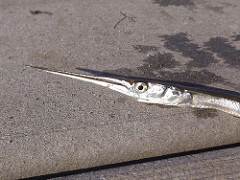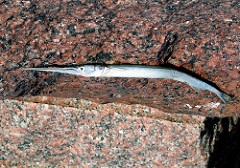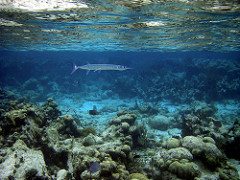Name of animal-plant: Atlantic needlefish
Species name: Strongylura marina
Strongylura marina, known commonly as the Atlantic needlefish, is a common demersal needlefish species common in marinas and other areas with minimal current. Its extremely long jaw and body set this fish apart from other predators. Atlantic needlefish are found from Maine to Brazil and have been known to venture into freshwater for short periods.
Spawning typically occurs in late spring and summer. In Texas, near ripe females have been reported in February. Females lay eggs that have many long filamentous tendrils which attach to floating vegetation or other submerged objects and organisms. S. marina reaches reproductive maturity two years after being born. Spawning activity occurs in shallow inshore habitats with submerged algal masses. S. marina depends on submerged vegetation for breeding and shelter. In the Gulf of Mexico, the eggs of S. marina attach to sargassum seaweed.
Animal type: FISH
A fish is any member of a group of organisms that consist of all gill-bearing aquatic craniate animals that lack limbs with digits. They form a sister group to the tunicates, together forming the olfactores. Included in this definition are the living hagfish, lampreys, and cartilaginous and bony fish, as well as various extinct related groups. Tetrapods emerged within lobe-finned fishes, so cladistically they are fish as well. However, traditionally fish are rendered paraphyletic by excluding the tetrapods (i.e., the amphibians, reptiles, birds and mammals which all descended from within the same ancestry). Because in this manner the term “fish” is defined negatively as a paraphyletic group, it is not considered a formal taxonomic grouping in systematic biology. The traditional term pisces (also ichthyes) is considered a typological, but not a phylogenetic classification.



Subcategory: m_pelagic
Pelagic fish live in the pelagic zone of ocean or lake waters – being neither close to the bottom nor near the shore – in contrast with demersal fish, which do live on or near the bottom, and reef fish, which are associated with coral reefs.
The marine pelagic environment is the largest aquatic habitat on Earth, occupying 1,370 million cubic kilometres (330 million cubic miles), and is the habitat for 11% of known fish species. The oceans have a mean depth of 4000 metres. About 98% of the total water volume is below 100 metres (330 ft), and 75% is below 1,000 metres (3,300 ft).
Fact:
All animals and plants are given a species name based on a technical term in biological taxnomy. The species name consists of two words and is based on Latin.
The first part of the name identifies the genus to which the species belongs and the second part identifies the species within the genus. In this animals case it is: Strongylura marina
Photos by Jo-fish, dog.happy.art, mddnrfish, jnnn_murphy,

